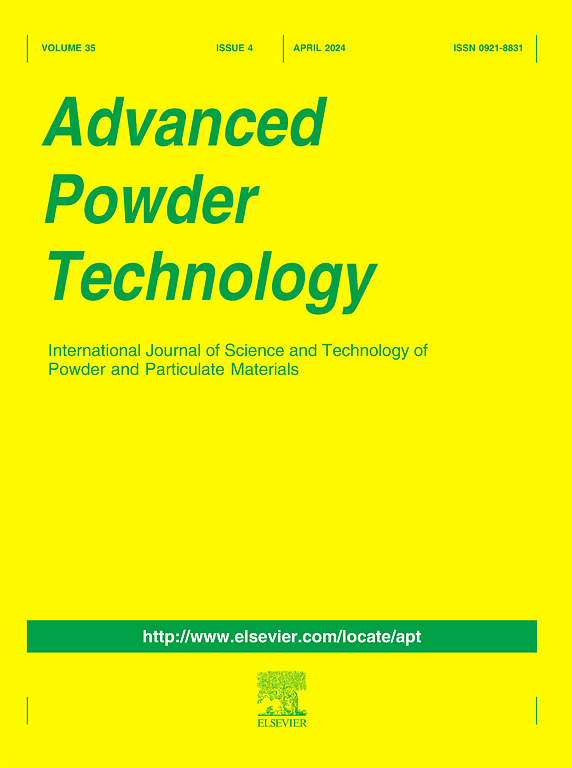Impact of ultrasonic vibration frequency on the quality of produced NiTi and NiTi-20Hf powders for additive manufacturing applications
IF 4.2
2区 工程技术
Q2 ENGINEERING, CHEMICAL
引用次数: 0
Abstract
The rapid expansion of additive manufacturing (AM) technologies has intensified the demand for high-quality metal powders and prompted the need for effective recycling solutions to address waste generation during production. This study investigates the impact of ultrasonic vibration frequencies (20 kHz and 40 kHz) in an Ultrasonic-Plasma Atomization (UPA) system on recycling NiTi and NiTi-20Hf pre-alloyed powders. The objective is to evaluate the effects of frequency variation on key material properties, including impurity levels, powder characterization, and microstructural homogeneity, to determine the suitability of the recycled powder for AM applications. The findings reveal that both vibration frequencies significantly influence the properties of the recycled powders. At 40 kHz, carbon impurities increased by 39 % in NiTi and 89 % in NiTi-20Hf, while oxygen contamination rose by approximately 150 % and 60 %, respectively, compared to the virgin powders. Similarly, at 20 kHz, carbon and oxygen impurities exhibited notable increases, albeit to a lesser extent. These increases are attributed to process-induced surface area changes, thermal oxidation, and equipment-related contamination. Despite the increase in impurities, the microstructural analysis, particle size distribution, and shape uniformity of the recycled powders demonstrated consistent properties, aligning with the quality requirements typically specified for AM feedstock, such as those outlined in standards like ASTM F3049 or equivalent guidelines. By addressing the challenges of impurity management and ensuring physical consistency, this research highlights the viability of ultrasonic recycling processes as a sustainable strategy to enhance material reuse and reduce resource dependency in the AM industry.

超声振动频率对增材制造中制备的NiTi和NiTi- 20hf粉末质量的影响
增材制造(AM)技术的快速发展加剧了对高质量金属粉末的需求,并促使人们需要有效的回收解决方案来解决生产过程中产生的废物。研究了超声等离子体雾化(UPA)系统中超声振动频率(20 kHz和40 kHz)对NiTi和NiTi- 20hf预合金粉末回收的影响。目的是评估频率变化对关键材料性能的影响,包括杂质水平、粉末表征和微观结构均匀性,以确定再生粉末用于增材制造应用的适用性。研究结果表明,两种振动频率对再生粉末的性能都有显著影响。在40 kHz时,碳杂质在NiTi和NiTi- 20hf中分别增加了39%和89%,而氧污染分别增加了约150%和60%。同样,在20千赫时,碳和氧的杂质表现出显著的增加,尽管幅度较小。这些增加归因于工艺引起的表面积变化、热氧化和设备相关污染。尽管杂质增加,但回收粉末的微观结构分析,粒度分布和形状均匀性显示出一致的性能,符合AM原料通常规定的质量要求,例如ASTM F3049或等效指南等标准中概述的要求。通过解决杂质管理和确保物理一致性的挑战,本研究强调了超声波回收工艺作为一种可持续战略的可行性,以提高材料再利用和减少增材制造行业的资源依赖。
本文章由计算机程序翻译,如有差异,请以英文原文为准。
求助全文
约1分钟内获得全文
求助全文
来源期刊

Advanced Powder Technology
工程技术-工程:化工
CiteScore
9.50
自引率
7.70%
发文量
424
审稿时长
55 days
期刊介绍:
The aim of Advanced Powder Technology is to meet the demand for an international journal that integrates all aspects of science and technology research on powder and particulate materials. The journal fulfills this purpose by publishing original research papers, rapid communications, reviews, and translated articles by prominent researchers worldwide.
The editorial work of Advanced Powder Technology, which was founded as the International Journal of the Society of Powder Technology, Japan, is now shared by distinguished board members, who operate in a unique framework designed to respond to the increasing global demand for articles on not only powder and particles, but also on various materials produced from them.
Advanced Powder Technology covers various areas, but a discussion of powder and particles is required in articles. Topics include: Production of powder and particulate materials in gases and liquids(nanoparticles, fine ceramics, pharmaceuticals, novel functional materials, etc.); Aerosol and colloidal processing; Powder and particle characterization; Dynamics and phenomena; Calculation and simulation (CFD, DEM, Monte Carlo method, population balance, etc.); Measurement and control of powder processes; Particle modification; Comminution; Powder handling and operations (storage, transport, granulation, separation, fluidization, etc.)
 求助内容:
求助内容: 应助结果提醒方式:
应助结果提醒方式:


